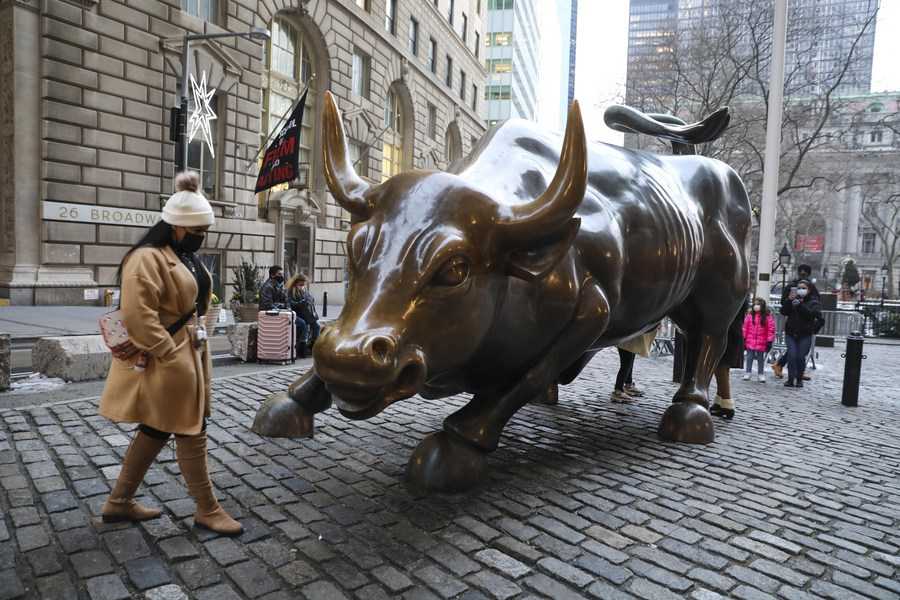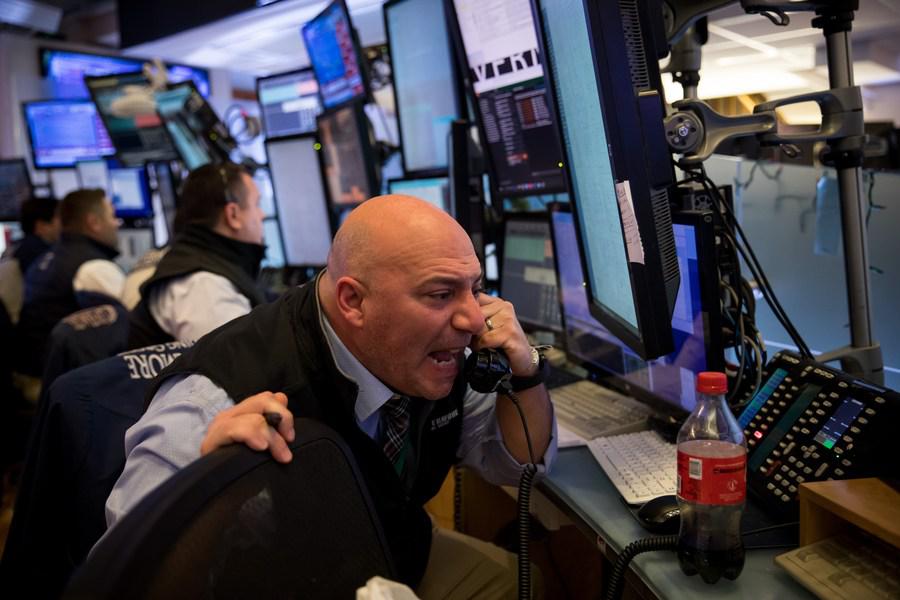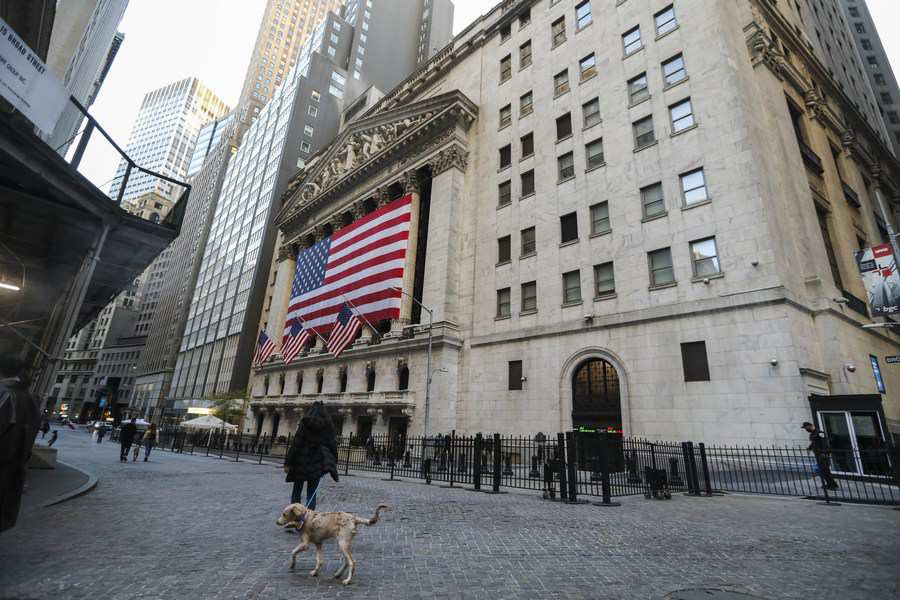U.S. value, cyclical stocks remain favored with outbound rotation stalled

A woman walks past the Wall Street Charging Bull in New York, the United States, Dec. 21, 2020. (Xinhua/Wang Ying)
U.S. cyclical sectors like energy, financials, industrials and materials have led the market higher since early November 2020 when positive vaccine news began to trickle out.
NEW YORK, March 21 (Xinhua) -- U.S. value and cyclical stocks continue to be strategists' favorite pick on multiple supportive factors while expected rotation outside of the United States did not go well due to divergence of economic recovery outlook in major economies.
U.S. value and cyclical stocks, which benefit hugely from economic recovery, are catching up in relative valuation versus growth stocks, which outperformed at the height of the pandemic.
Dow Jones Industrial Average index gained 3.6 percent in last month while Nasdaq index fell 4.75 percent in the same period, as U.S. new stimulus package stoked optimism on recovery with growth stocks hurt by rising long-term Treasury bond yields.

Traders work at the New York Stock Exchange (NYSE) in New York, the United States, on March 18, 2020. (Photo by Michael Nagle/Xinhua)
VALUE, CYCLICALS TAKE LEADERSHIP
The shift in equity leadership toward last years' laggards has been given a further boost by the passage of the 1.9-trillion-U.S.-dollar economic stimulus in the United States, said Mark Haefele, chief investment officer of UBS Global Wealth Management on Thursday.
Rising bond yields have contributed to the strong performance of value stocks relative to growth and technology stocks, said Haefele.
U.S. cyclical sectors like energy, financials, industrials and materials have led the market higher since early November 2020 when positive vaccine news began to trickle out, said research firm MRB Partners on Friday.
MRB Partners said it expects cyclical sectors to continue to exert market leadership in the year ahead given the prospects of strong economic rebound once a large share of the population is inoculated.
With inflation, stimulus and an accelerating economic expansion all at play, "we think investors should still be positioned tactically for a continuation of the 'reflation trade,' particularly in energy, financials, and small caps," added Haefele.
Haefele noted that these above-mentioned sectors should all benefit from a more robust economy and higher yields, which are likely to continue to create near-term volatility and uncertainty for some growth stocks.
In the phase of strong inflation, small caps and value stocks have typically outperformed large caps and growth stocks, and the profits recovery and economic rebound this year would provide further support to the trend, said Bank of America Global Research recently.
Value, small cap and international equities are favored over growth stocks for a cyclical recovery, said Barry Bannister, head of institutional equity strategy with U.S. brokerage and investment banking firm Stifel, on Thursday, adding that value stocks are breaking out after deep underperformance in near four years leading to September 2020.
Supportive factors for the breaking out include a leveling dollar, gradual reflation, a rising 10-year Treasury bond yield, a topping out of stock market valuation and penetration measures, rising U.S. broad money supply and commodity upturn developments, according to Bannister.
In the base case, the rotation into value and cyclical will continue in the near term with the support of broadening recovery and faster growth, said Haefele.
Value stocks could outperform growth stocks by 40 percent cumulatively from the fourth quarter of 2020 to the third quater of 2024 with the help of a cyclical commodity recovery, said Bannister.
Haefele said of a new paradigm consisting of sustainable high nominal growth and higher yields emerges, "the value trade could run for years."
Investors should take the opportunity to build some exposure in value stocks, both for near-term performance and as a hedge against a potential change in the market regime, according to Haefele.

Pedestrians walk past the New York Stock Exchange in New York, the United States, Nov. 4, 2020. (Xinhua/Wang Ying)
U.S. EQUITIES COULD RISE FURTHER
The U.S. equities look still attractive versus the bonds and a number of overseas equity markets, though the elevated valuation of U.S. equities raises concerns about bubble.
In the base case, the S&P 500 index has a target price of 4,200 points by December 2021, up from closing of 3,913.1 points on Friday, and total earnings per shares with S&P 500 index members will rebound to 182 U.S. dollars in 2021 and 205 dollars in 2022, respectively, according to the UBS.
Member companies under S&P 500 index had total earnings per shares of 122.37 dollars, according to the latest estimate by Howard Silverblatt, senior index analyst with S&P Dow Jones Indices.
Bannister said if the Federal Reserve ever explicitly represses the nominal and thus real 10-year Treasury bond yield, that would risk a major equity bubble so long as inflation remain low.
A bubble could quickly add cyclically adjusted price to earnings ratio (CAPE) by 11 multiples, leading the S&P 500 index soaring to around 5,300 points, according to Bannister.
Haefele added that equities still are attractive for longer-term investors as dividends alone from S&P 500 index are likely to offer higher returns than bond coupons from U.S. Treasuries in the next decade.
In addition, divergence within the technology sector and headwinds from rising bond yields don't mean this is the beginning of the end for tech investing, according to Haefele.
The budding rotation in global equities away from the United States has paused with U.S. corporate earnings expectations getting a huge boost from fiscal stimulus and Federal Reserve's promises to lag the cycle for several years, said MRB Partners.
MRB Partners said it still holds a slight overweight on the U.S. equities in light of outperforming U.S. earnings outlook and courtesy of massive fiscal stimulus.
While still keen to eventually downgrade our overweight in the United States within a global equity portfolio, "we are staying patient until the euro area looks likely to achieve a meaningful recovery in its recessionary service sector," said MRB Partners.
Investors are expected to rotate from U.S. growth and tech stocks into value, cyclical and selective foreign equities under the assumption of synchronized recovery from the pandemic.
However, divergence of vaccination, fiscal stimulus and monetary policy has complicated the rotation process particularly in the last few months.
Photos
Related Stories
- Dialogue, win-win are right choices for China-U.S. relations
- China, U.S. hold candid, constructive dialogue, keeping door open to further communication
- Anti-Asian crime: a plague the U.S. fails to address
- Obstacles to U.S. attempt to solidify trilateral cooperation with S. Korea, Japan
- UN review exposes dark side of U.S. human rights record
- S. Korea, U.S. defense, foreign ministers hold "2+2" talks about Korean Peninsula, regional issues
- Senate unanimously confirms Katherine Tai as U.S. trade representative
- Senate unanimously confirms Katherine Tai as U.S. trade representative
- Suspect in Atlanta shooting spree charged with multiple counts of murder
- Outcry against anti-Asian violence erupts amid ongoing investigation into Atlanta shootings
Copyright © 2021 People's Daily Online. All Rights Reserved.










